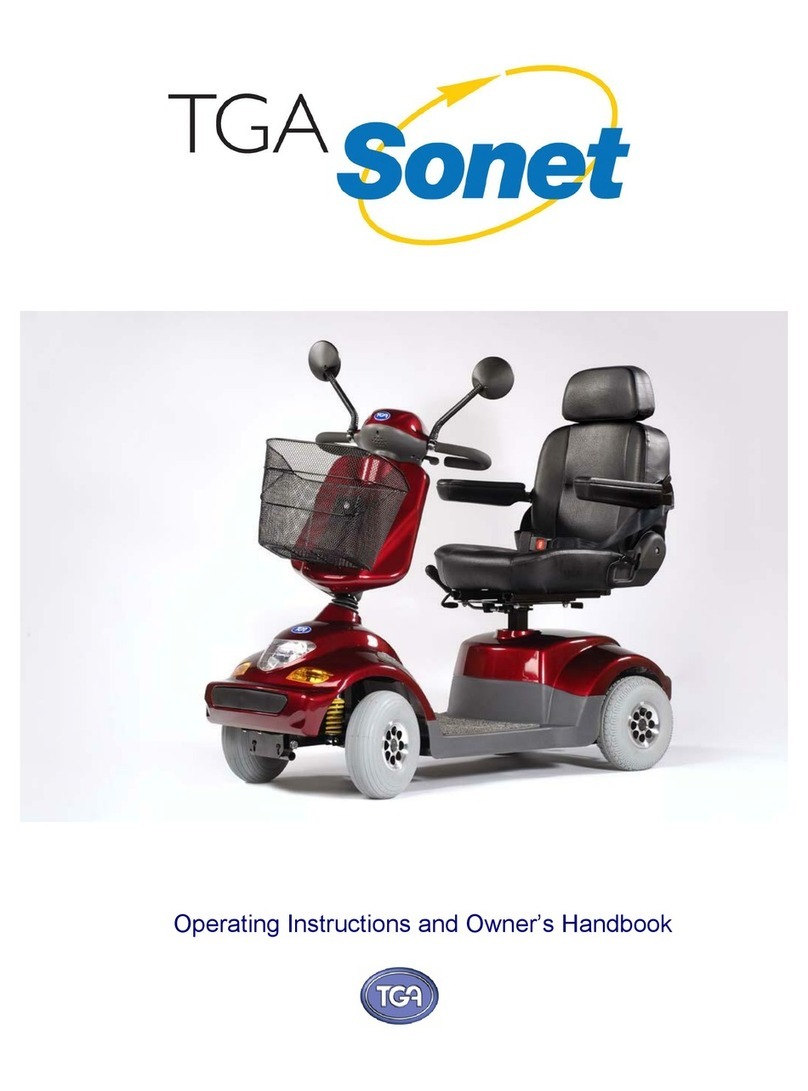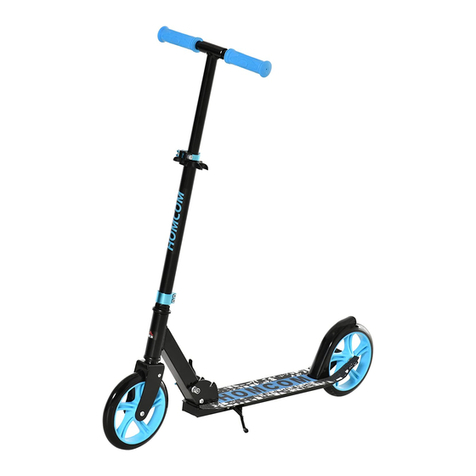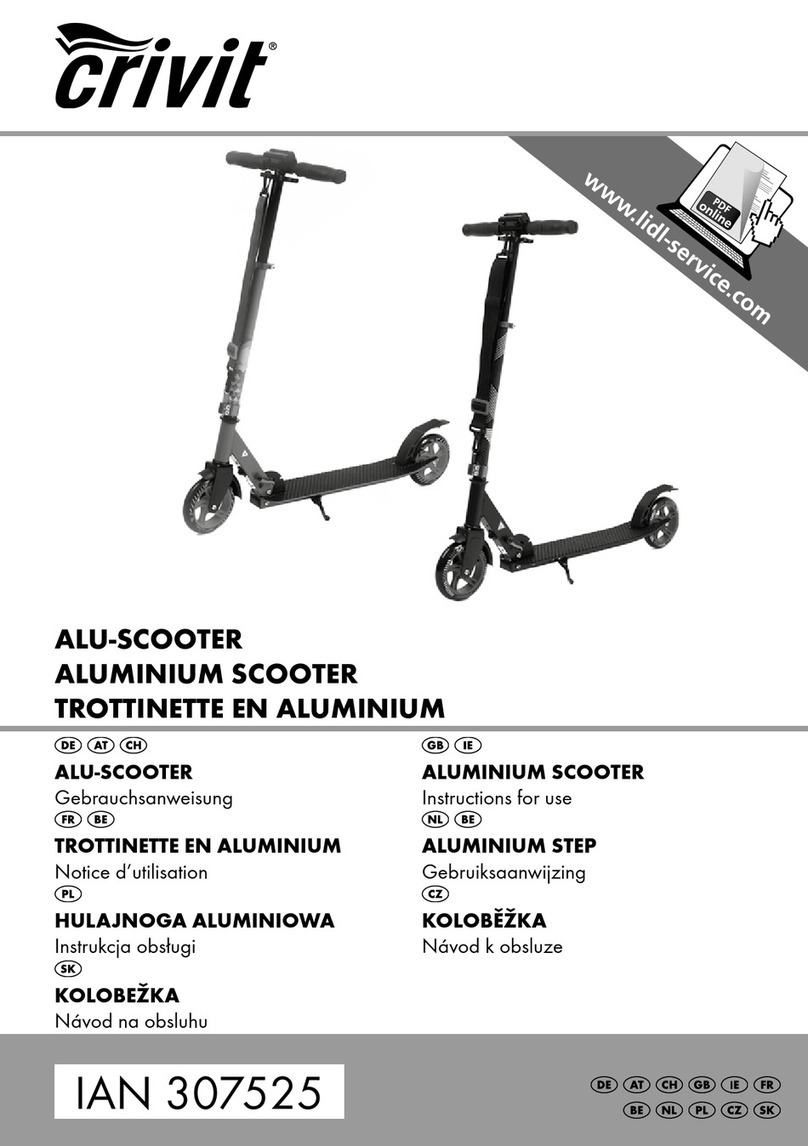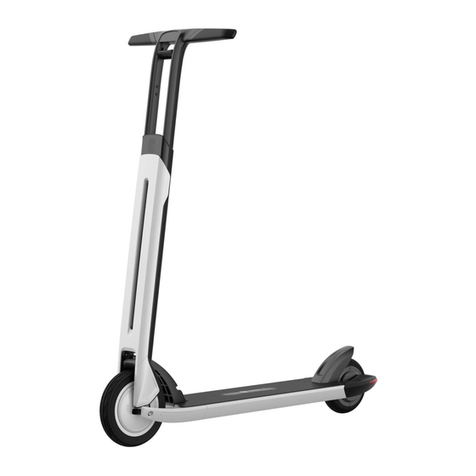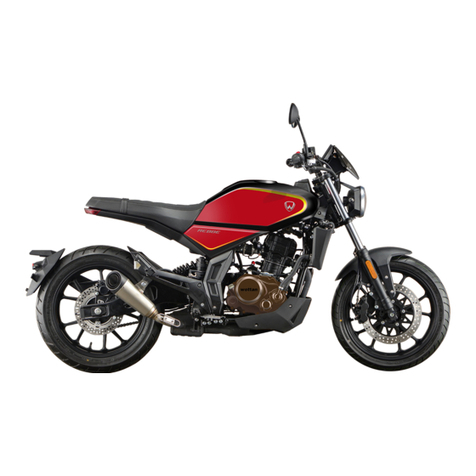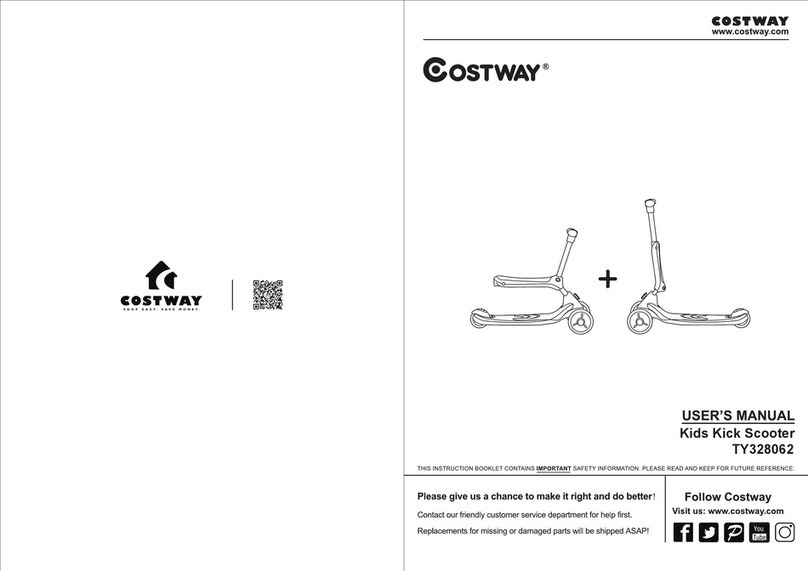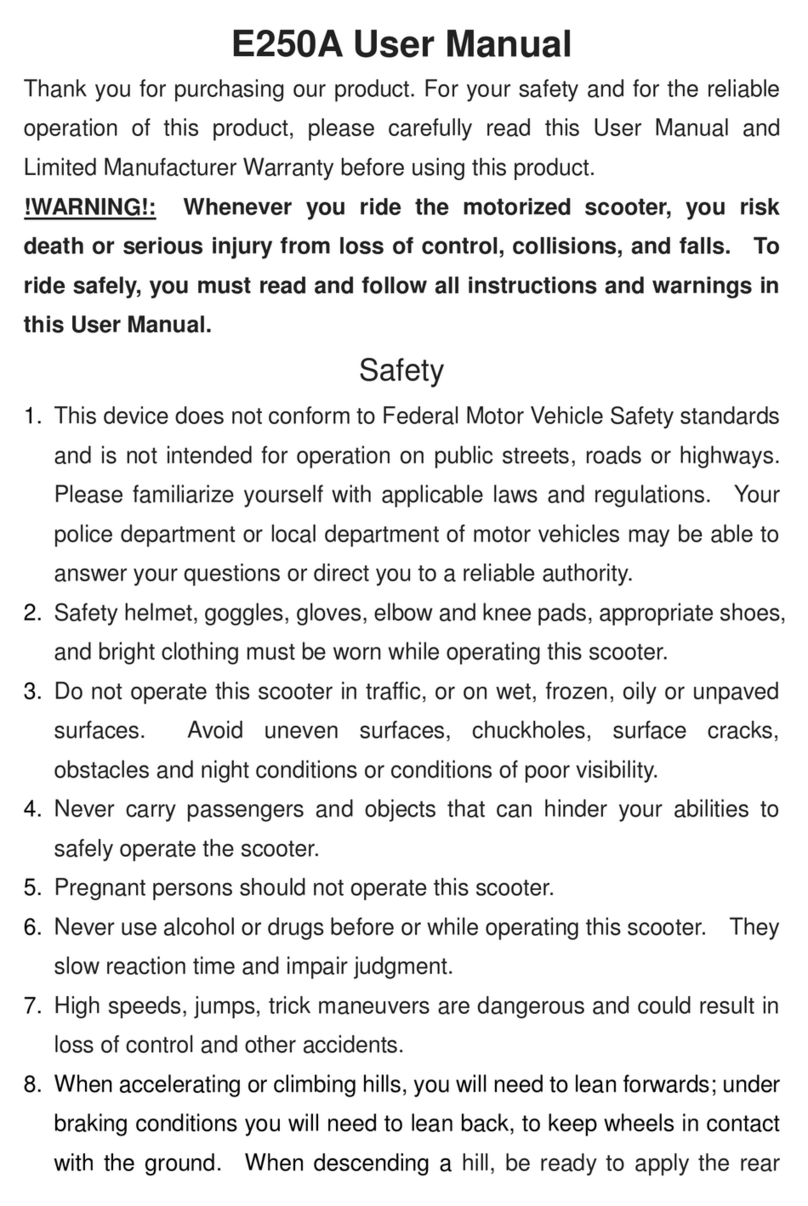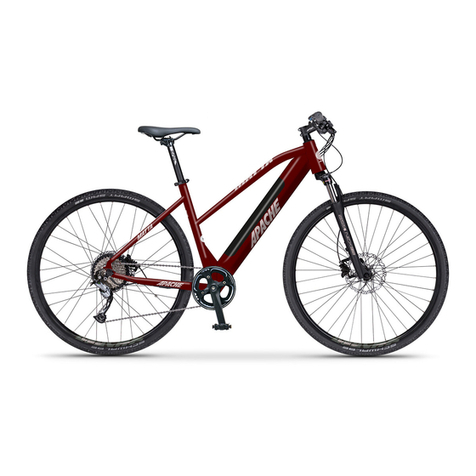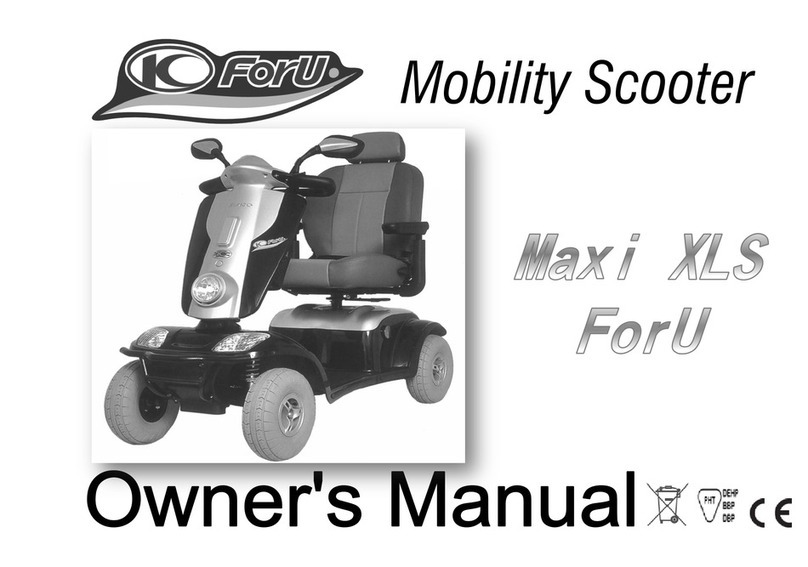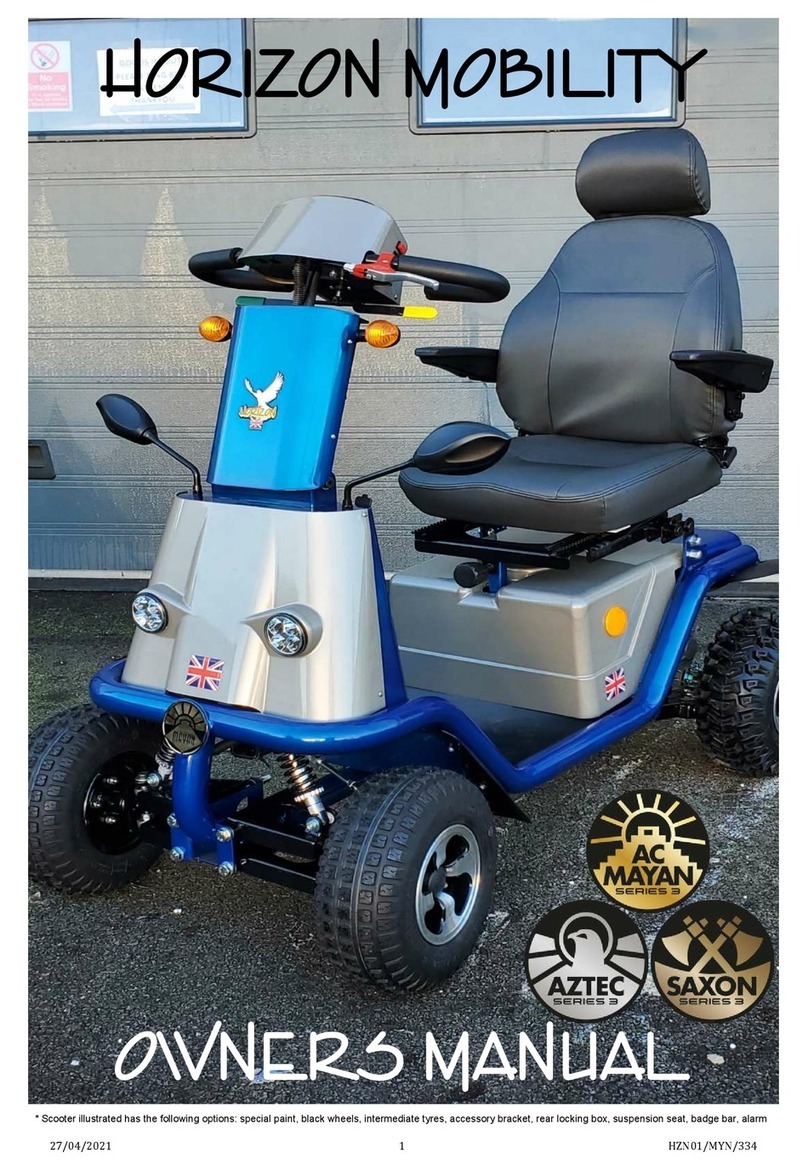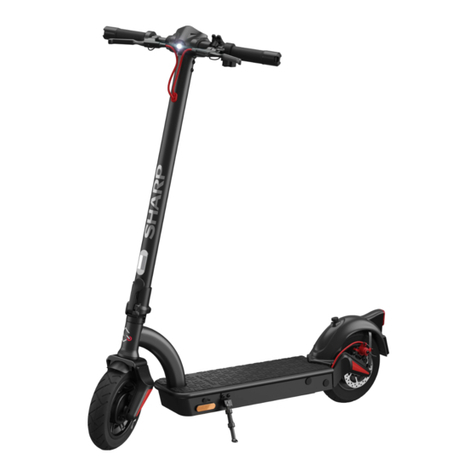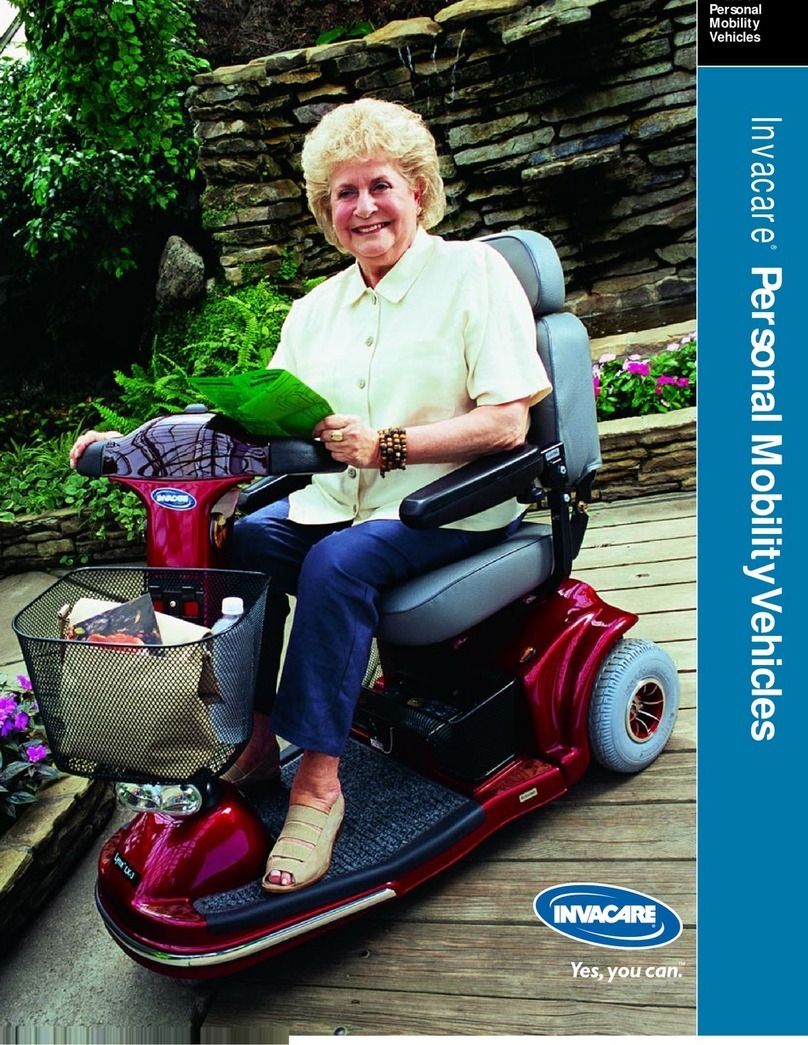TGA Breeze3 Quick start guide

Breeze3 & Breeze4 Operatin
g
Instructions and Owner’s Handbook

CONTENTS CHAPTER
INTRODUCTION 1
ASSEMBLY 2
PREPARETHEBREEZEFORFIRSTUSE 3
THECONTROLSANDINSTRUMENTPANEL 4
SEATADJUSTMENT 5
DRIVING 6
TRANSPORTINGBREEZE 7
PARKINGBRAKERELEASE 8
SAFETYOVERLOADSWITCH 9
TIPS, CAUTIONS, PROBLEMS AND ADDITIONAL FEATURES 10
BATTERYCHARGING 11
AGUIDETOSAFEANDLASTINGBATTERIES 12
MAINTENANCE 13
TROUBLESHOOTING 14
TECHNICAL SPECIFICATIONS 15
WARRANTY 16
SAFEDRIVINGTIPSFORSCOOTERUSERS 17

1. INTRODUCTION
The Breeze – Outdoor Powered Scooter: Thank you for purchasing from TGA. We hope your Breeze will bring
uch freedom and pleasure to your life.
his handbook provides important information on the most common operational and maintenance concerns that
is able
operate the controls competently before venturing far from where there is assistance. this
andbook for future referral.
ng
Do not exceed the maximum gradient/slope of 21°.
Do not get on or off your Breeze unless it is switched off.
Do not back your Breeze into uneven inclines or surfaces. Be cautious when traversing slopes.
Do not turn suddenly at full speed, especially on uneven or hilly ground. Failure to observe this may result
Do not drive your Breeze unless the seat is locked into the driving position.
. soft dirt, deep grass, loose gravel).
Do not operate your scooter when under the influence of alcohol or certain drugs, which may impair your
Do not climb or descend curbs that exceed the Breeze’s capability.
Always stop fully before changing direction (forward or reverse).
Always proceed carefully while riding your scooter, especially as you approach the downgrade of a ramp or
Always proceed carefully while riding on uneven surfaces. that
it cannot move in the vehicle and transfer yourself to a vehicle seat.
Never attempt to freewheel down a slope as all braking will be lost.
that of others please ensure that you thoroughly read and understand this and in addition always obey the
rules of the road.
ntended Purpose
he Breeze is intended for outdoor use and is fitted with large wheels and fully active front and rear suspension
aking it ideal for rough terrain and cross country as well as normal use. It is capable of climbing slopes up to
1% and negotiating obstacles up to 12cm. Care must be taken when using in these conditions.
avement Use
he speed of the Breeze is dependant on the weight of the occupant, incline and the type of surface. Tested with a
eight of 18 stone (114.55kg) the Breeze had a speed of 7.5/8mph on the flat, on high speed setting. When used
n the pavement, the UK law limits the speed to 4mph. For pavement use make sure 4mph is selected, and drive
ith care.
m
T
the user should be familiar with. It is very important that the user is familiar with the driving technique and
to
The handbook will draw your attention to important safety related issues by
Care! Warning
Labeling. Keep
h
Care! Warni
* Do not ride your Breeze without fully reading and understanding this instruction manual first.
*
* Do not carry passengers or exceed the maximum carrying weight (see Technical Specifications).
*
* Do not switch your Breeze on with the speed control lever depressed.
*
* Do not drive your Breeze in a confined space unless the speed adjustment is set to low.
*in tipping of the scooter.
*
* Do not drive your Breeze over deep, soft terrain (e.g
*safety.
*
* Do not turn when negotiating curbs. Always approach curbs at low speed and straight.
*
* Always keep your feet on the vehicle when driving.
*hill.
*
* Do not sit on your Breeze while being transported in a moving vehicle. Always restrain the scooter so
* Do not drive your Breeze through deep water or clean with a high pressure hose.
*
* Safe driving tips for scooter users have been printed in the back of this manual. For your own safety and
I
T
m
2
P
T
w
o
w
2

2. ASSEMBLY (WHERE NECESSARY)
emove all the items from the carton and strip the protective packaging materials off each item. Returns are only
o the forks using the
eat with the four allen headed bolts, making sure the adjustment levers are to the
ont.
seat
and out. Replacing the seat is just a reversal of
p or down to
ated at the top rear of the
ver. rectly.
Batteri safety in transit the main supply leads may have been disconnected from the batteries. The black
the other. These will be taped to the
bolts are correctly
3. PRE E THE BREEZE FOR FIRST USE
will requ
safe are
obstacle lat. Mark a practice course for straight line driving, turning in confined spaces, reversing
nd driving around obstacles.
l Levers - The speed of Breeze is controlled by the
ver located on the right hand handlebar and shown in Fig 1.1.
parking brake will engage and stay on until the machine
oves off again. The lever is also fitted with a panic sensor which is
ctivated if the lever is pulled in hard against the handlebar. If this
appens all power to the motor will be shutdown and the brakes will
me on immediately causing the machine to stop very suddenly.
The Breeze was pre-delivery inspected and tested prior to dispatch. The batteries may have been disconnected for
delivery purposes only.
R
accepted when the product is shipped in the original cartons with the original packing material installed.
Breeze 3 will have had the front wheel and the seat removed. Replace the front wheel int
components supplied and refit the front brake cable. Ensure the wheel nuts are securely tightened. Next fit the
seat plate to the base of the s
fr
Breeze 4 will just have the seat back and tiller folded down.
Removal and Replacement of seat – To remove seat, release the seat locking lever, fig 5.1, and turn
through 180° so that it faces to the rear. Now lift seat straight up
the above.
Tiller Adjustment – Release the tiller adjusting lever by pulling outwards, then move the tiller u
your choice. Make sure it locks in before use, fig 5.3.
Rear Cover Removal – Remove seat, then unscrew the two black fixing screws loc
co Remove cover. Replacement is just a reversal of the above, ensuring the cover locates cor
es – For
lead would have been disconnected from one battery and the red lead from
batteries in an obvious position as will the fixing bolts. Simply reconnect the leads ensuring the
tightened.
PAR
If you receive your Breeze packaged and it has to be assembled see the section covering Assembly. The batteries
ire charging - refer to Charging the Breeze for details.
Care! Warning
The Breeze is easy to drive but it is essential that you familiarise yourself with the controls and learn to drive it in a
a with sufficient room to manoeuver for your safety and that of others. The area should be free of
s and reasonably f
a
4. THE CONTROLS AND INSTRUMENT PANEL
Figs 1-4 Provide details of the control system. Listed below are the various controls and their uses.
1. Speed Contro
le 1.4
1.1
1.2
1.3 Fig 1
Always use the lever gently, remembering that the more you squeeze
the lever in the quicker you will go. To stop simply release the lever,
the braking is completely automatic and when the machine has
stopped the
m
a
h
co
3

Please be aware of this fact and brace yourself accordingly. There are several reasons for this to be fitted. 1. to
top the throttle becoming pulled on accidentally causing a dangerous situation. 2. to stop intentional very rapid
l panic and pull the lever even harder. With this sensor fitted, in an emergency situation
een
tted with one of the following factory fitted options:- of
stop simply release or wind back the lever, fig 1.2
Foot Pedal Speed Control - Again much the same as above but used with the foot and not the hand. Simply
wist grip and foot throttle are not fitted with panic
nsors.
never need to be used. It is only for emergency use, in the very unlikely
vent that the automatic braking fails. If used this lever will cut off the power of the
. Horn – Buttons located either side of handlebar (fig 3.1). The buzzer can be
) (fig 3.2).
. Indicator Warning Lights - Come on when using indicators (fig 4.1).
. Hazard Warning Lights - Operates all indicator lights together. For emergency use only and can be
. Head Light Switch - This switches on front and rear lights, and located at fig 3.3.
his has a removable key which
ould be taken out when machine not in use. When the key is
serted the switch has two positions, “off” where there will be no
engaged and
on” where the machine is ready for use (fig 3.4). If Breeze is
self down to conserve battery. To restart, turn the key to off, wait
.3)
sp a
WA ING Always come to a complete stop
s
acceleration. 3. for emergency use. 4. it is possible that when in an emergency situation, instead of releasing the
throttle some people wil
which ever direction the lever goes the machine will stop. In normal use take care not to pull the lever hard onto
the handlebar. It is best to familiarize yourself with this safety device. You may have a machine that has b
fi
a) L/H speed Control Lever - This is used exactly as described above and is fitted to the L/H handlebar instead
R/H
b) Twist Grip speed Control – Twist the throttle gently to engage power, the more you twist, the quicker you will
go. To
c)
release pedal to stop, located on the footplate RH side. NB T
se
2. Emergency Brake - All braking on the Breeze is automatic and the emergency
brake should
e2.1
machine and bring you safely to a halt. Lever located on left handle bar (fig 2.1).
3
enabled to automatically sound when using reverse and the indicators (deactivated as
standard).
4. Indicators - Left and right hand located on the L/H handlebar. Push the switch in
the same direction as you need to turn. To stop the indicators, push the button
forward. The buzzer can be enabled to sound whilst indicators are in use (deactivated
as standard
2.2
Fig 2
5
6
accompanied by an audible warning (deactivated as standard) (fig 2.2).
7
8. Head Light Warning Light - Will come on when lights are in use. Lights will reduce range of scooter. Use
only when necessary (fig 4.2).
9. Power On/Off Switch - T
3.3
sh
in
power to the machine and the parking brake will be
“
inadvertently left switch on, after a certain period of time it will shut
it
a few seconds and turn on again.
10. On Light – Will come on when the key is turned to on and
Breeze ready for use (fig 4.3).
11. Forward/Reverse Switch – Located on the RH handlebar (fig 1
pressing either side of switch as marked. When using reverse the top
warning buzzer will sound (warning buzzer deactivated as standard).
before changing selector switch.
3.5
3.2 3.1 3.1
3.4
Fig 3
y. Select your desired direction b
eed is automatically reduced and
RN
4

12. Speed Selector Switch – This is located on the RH handlebar (fig 3.5). It has two positions, ‘1’ which is the
high speed (approx 8 mph) and ‘1/2’ which is the slow speed (approx 4mph). CARE WARNING – It is a legal
requirement not to exceed 4 mph on footpaths or shopping areas. Always use the slow speed when driving inside
buildings, crowded areas, sales, stately homes etc. Using the faster speed in these sorts of conditions presents a
serious danger both to you and people on foot. Don’t forget these machines are very quiet and others may not be
aware of your presence. The 8 mph speed is only legal for road or off road use.
t be used. The
ill resume normal power to Breeze. The other function of this
dicator lamp is a warning of motor overheating, which may have been
the light does not clear (fig 4.5).
lectronically operated device as well. To use, switch on the keyswitch and squeeze the button located
t the front of the RH handlebar. This will release the brake and allow the scooter to be moved (fig 1.4).
rs, consisting of 3 red, 4 amber,
y to be in a good
you reach the middle of the amber you should be thinking of recharging and when you get
own to the last 2 red it is important to get it on charge as soon as possible. At this point there maybe around 2
r and different types of terrain will
chieve different results. It is important to only use Breeze on short runs to start with to explore the sort of range
. SEAT ADJUSTMENT
. For ease of entry and exit to Breeze the seat will swivel
d at the front of the seat
ig 5.1). Make sure the seat locks in before either getting
to preferred height.
13. Speed Select Light - Will come on when ½ speed (4mph) is selected (fig 4.4).
14. Inhibit Warning Indicator – As soon as the charger plug is connected
to Breeze, the machine is automatically inhibited and canno
Inhibit Warning Lamp (fig 4.5) will come on when the keyswitch is turned to
on, warning you of this situation. Switching off and disconnecting the
charger w
in
caused by extremely hot weather conditions, or climbing a very long and
steep hill or several other situations that may have overloaded the motor
causing overheating. At this point the indicator light will flash on and off.
You must stop and allow the motor to cool down for 15-30 minutes or longer
if
15. Brake Release Button – In addition to the manual brake release, Breeze is fitted
handlebar e
4.5 4.4
4.3
4.6
4.2
4.1
4.1
with a very convenient
a
16. Battery Condition Indicator (Fig 4.6) – Consists of 10 individual light ba
and 3 green. All 10 bars lit show a fully charged battery. Any of the greens lit show the
state of charge. When batter
d
miles of use left. It is impossible to be more specific than this as every ride
a
you will be achieving. Then when you are confident about range, start going on longer journeys.
Fig 4
5
1
to the left or right with two lock in positions each side at
45° and 90°. The lever is locate 5.6
5.3
(f
on or off, or driving.
2. The seat adjustment lever located at the front of seat
allows the seat to be adjusted forward or backward (fig
5.2).
3. Armrests can be raised or lowered allowing easier entry
and exit.
4. Backrest can be adjusted by releasing the lever on left
hand side of backrest.
5. Headrest can be made higher simply by pulling gently
upward. To lower there is a small lever located on the top
of the seat at the base of the left hand headrest support.
Simply press the lever and adjust
5.2 5.1
5.5
5.4
Fig 5
5

6. The seat height is adjustable by altering the position of the seat stem. Remove the seat and rear cover and you
will see the seat stem is held in its location by a single bolt. Remove the bolt and the seat stem can be adjust
up or down to any one of its fixing holes. Adjust to your preferred position and tighten bolt. Refit cover and seat.
6. DRIVING
Before driving make sure that the Battery is fully charged, check that the tyres do
ed
not appear to be soft, see
aintenance section for details of monthly checks and tyre pressures. Check that the Key is switched OFF before
sure that the armrests are in
e down position.
qu t control l r to move
lwa ome to a stop before
own and stop. Once stopped, the parking
nd squeeze the right control lever again. The speed in rev reduced
utomatically for safety.
stop
st short of the edge and:
anual.)
cator. The distance you can travel depends on many factors, the more slopes, the less
istance you can travel. We recommend that
are
allow the battery to “recover” a little power so that y
s. If you are unfortunate and cann home
er there is a “Free Wheel” device that will allow someone to push the Breeze home (see
arking Brake Release).
, ally decrease the range. Establish w
n obtain around your locality by gradually increasing the distance and checking the battery indicators at the
nd of each journey.
e speed will also reduce the power. For climbing obstacles or hills you will need to increase the
eed setting to give the power and then control the speed with the levers.
. Before leaving the scooter, switch the ignition off, the battery indicator will then go off Remove the ON/OFF
e Parking Brake lease), i ERY IMPORTANT to re-
before you alight.
3. Flip up the armrest to make it easier to alight from the Breeze, or swivel the seat through 90°.
M
entry. When comfortably sat, ensure that the seat lever has locked the seat secure. En
th
1. Set the Breeze speed to slow. Hold the Tiller with both hands and gently s
the Breeze forward. The more you squeeze the lever, the faster you will go. A
changing H or L speeds, or forward and reverse.
2. Releasing the control lever automatically operates the brakes to slow d
brake will automatically come on.
3. Use the Tiller to steer.
4. To go backwards, select reverse a
eeze the righ eve
ys c
erse is
a
5. To negotiate from pavement to road, or road to pavement, you should try to find a suitable slope. The Breeze
will mount, or go down kerbs 12cm high, but you should approach a kerb at right angles (90°). You should
ju
* If you are going up; select the high speed setting then drive until both front and back wheels are on the
pavement, then immediately lower the speed.
* If going down, proceed slowly on low setting until on the road, then switch to a suitable higher speed to
cross the road safely.
6. The Breeze is suitable for road use BUT great care must be taken and at the maximum speed of 8 mph, you
may present a hazard to other faster moving road users. (See safe driving tips at the rear of this m
7. Watch your Battery Indi
dyou gradually explore going further each day.
8. Should the battery “run out” before you get home there
Stopping and switching off the KEY for 5 – 10 minutes will
can proceed further. You can attempt this a number of time
under the battery pow
two things you can do to avoid being stranded. ou
ot return to
P
9. Range is influenced by many environmental conditions
you ca hathills will substanti
e
10. Reducing th
sp
Parking
1 .
Key for security.
2. If the Breeze has been used in the Free Wheel mode (se
engage the drive to ensure that the scooter brake is on Re t is V
6

7. TRANSPORTING BREEZE – When transporting Breeze in a motor vehicle the height can be reduced by the
removal of the seat and laying the tiller flat. Everything however must be securely strapped down including the
scooter itself and anything removed from it. The user must never travel in a vehicle seated on Breeze but should
transfer to a proper vehicle seat. CARE WARNING – All components are heavy, seek help if you think you may
mal use, pulled up releases the brake and allows Breeze to be pushed. There will be no power
drive Breeze when the brake is in this position, however when switched on the ‘on’ light will come on but the
otected electrically and electronically by 2 overload switches.
hey are designed to ‘pop-out’ should an overload or serious electronic fault occur. Possible examples that could
mage.
ne of the switches covers the charging circuit and the other covers the drive side of Breeze. This is located at
r in the middle and directly behind your legs (fig 5.5). Should this switch become
ctivated for whatever reason it will cause a complete electrical shutdown and the parking brake will come on. d
reset get in touch with your dealer. Never attempt to hold the button in by any other
eans. The charging circuit switch is located at the rear right hand side of the front panel, in front of your right s
If you d ion or noise in the operation of your Breeze, try to determine the cause. Be sure the
ower is off before investigating. If you cannot discover the cause of a problem contact your Breeze dealer for
irline Checking
with the airline before
and. An airline compliance certificate is available from TGA.
e
ean all exterior surfaces, touch-up any damaged paint. Check and inflate the tyres (see
chnical specification on page 10). Be sure the battery is fully charged before prolonged periods of storage and be
GING
ility
hargers may permanently damage
our batteries and would void the warranty.
. Switch OFF your Breeze and remove the key.
scooter cannot be driven.
. Push the plug from the charger into a suitable wall outlet and switch on.
injure yourself when lifting.
8. PARKING BRAKE RELEASE – In addition to the Electronic Brake Release (Section 4.15), Breeze is fitted with
a manual brake release. This is located within the wheel arch just in front of the right hand rear tyre (fig 5.4). The
down position is nor
to
Battery Indicator lights will flash indicating a fault mode. Never release this lever when Breeze is on a slope.
9. SAFETY OVERLOAD SWITCH – Breeze is pr
T
cause the overload switch to activate could be, steep or very long slope or high kerb causing overloading and
overheating or possible accident da
O
the front of the motor cove
a
Switch off, allow a few minutes and push the button in to reset. If it will not reset, leave a few more minutes an
try again. If it refuses to
m
knee. If Breeze will not charge, switch off, allow a few minutes and reset. If it will not reset follow the instruction
above.
10. TIPS, CAUTIONS, PROBLEMS AND ADDITIONAL FEATURES
Stop Problems before they Start
etect an unusual vibrat
p
help.
A
Sealed Lead Acid Batteries are permitted on aeroplanes. A sticker on the battery case states what they are. Airline
personnel may insist on removing the battery cover to verify its contents. It is best to check
h
Storage
Avoid storing your Breeze in locations with extreme heat or cold. A cool dry location is ideal if possible. The
following steps will help keep rust and corrosion from impairing your scooters function and appearance. Turn th
key to the off position. Cl
te
sure to recharge every 6 weeks. Failure to comply may result in battery replacement.
11. BATTERY CHAR
The battery charger supplied is special to your Breeze and so it may not be suitable for any other powered mob
product. Only use the charger supplied with your Breeze as other makes of c
y
To charge your batteries follow these simple steps.
1
2. Plug the charger lead into the socket located on the side of the handlebar console (fig 5.6). Plugging the
charger into Breeze automatically cuts all power to the electronics and the
3
7

4. The red light will come on for “mains on” as will an amber light indicating the battery is charging. Green will
light when the batteries are fully charged.
5. When the batteries reach their charged state, the charger will automatically stop charging. The lights will,
however, still be on but the batteries cannot overcharge.
6. Although to get out of trouble the batteries can be put on charge for a short period of time, it is always best to
o through a complete charge cycle each time. Excessive short period charging will be detrimental to battery life.
. For the best results your batteries must be cycled for their first 10-15 charges. This means run them down as
e as
after approximately 12 cycles of discharge and recharge.
complete charge – Do not switch off, unplug or interrupt the recharge cycle until the charging cycle has
mpleted.
G BATTERIES
our Breeze is not used for a period of time, a refreshing charge should be given every 4-6 weeks. Never
ave your batteries in a discharged condition. This is particularity important to sealed batteries such as the type in
aking sure they are tight and clean.
Breeze is fitted with sealed maintenance free batteries especially designed for powered mobility. They do not
ping up and will not leak out even if batteries are inverted.
amage is not covered by
ranty.
l service and maintenance check by your Breeze Dealer or TGA. The
llowing are weekly/monthly checks that will keep the machine in good running order.
led bearings and nylon bushes eliminate the need for
brication.
nce
ar.
g
7. For the best results and to prolong battery life, try to run the battery down by at least 50% before recharging
and in addition it is always best to go through a complete charge cycle each time.
8. Depending on the depth of the discharge, the minimum time taken to recharge serviceable batteries fully will
vary up to 12 hours. Please note that this time may increase as batteries get older. During periods without use
(perhaps during the winter) it is wise to charge the batteries every 4 to 6 weeks.
9
much as you safely can in use and then give them a full charge. They will not work at their best until this process
has been carried out.
You will find that the distance that your Breeze can travel will gradually increase over the first few weeks of us
the batteries reach their optimum efficiency
Care! Warning
* Do not smoke or use a naked flame while your batteries are being charged.
* Do not use the charger if it has received a sharp blow, been dropped or otherwise misused in any way. Take it to
a qualified technician.
* Do not dismantle the charger. This will void the warranty.
* Do not leave charger plugged into your Breeze with charger switched off as this may discharge your batteries.
* For a
co
12. A GUIDE TO SAFE AND LASTIN
* For longest life, your batteries should be recharged after reasonable use.
* If y
le
your Breeze.
* If your Breeze is to be stored away for some time, make sure the batteries are fully charged before storing.
Fully charge the batteries before re-using it.
* Every six months, check the connections on the batteries, m
*
require top
Batteries carry a limited warranty from the original manufacturer, which is subject to a stringent
Wear and tear clause. Any battery faults due to a defect by the original manufacturer will normally
become obvious within the first two months. Any gradual deterioration in performance after this
period is normally associated with fair wear and tear; misuse or accidental d
the manufacturer’s war
13. MAINTENANCE
We recommend that the Breeze has an annua
fo
•Do not apply oil or grease to any components. Sea
lu
• Keep all components clean and dry.
• Keep tyres inflated according to technical specification on page 10. Low tyre pressure will degrade performa
so it is very important to check pressure frequently.
• Check tyres for wear. Replace as soon as there is any sign of excessive we
8

• The Breeze uses maintenance free batteries, they are leak-proof regardless of position. Charging the battery is
the only maintenance required (refer to cha
rging instructions). DO NOT leave the batteries flat, charge every 4-6
secure.
ood. Do not use
ion in the Warranty Terms section).
n be used
keep the paint and bodywork in pristine condition. Do not use abrasive cleaners or strong detergents as this will
.
:
Servicing of the drive electronics and charger should only be carried out by your local TGA service
ealer. These units are sealed and should not be opened. BROKEN SEALS WILL VOID YOUR WARRANTY.
itions i.e. very heavy rain. DO NOT drive through deep
ater. This could damage the main electronic controller, or other electronics.
is
riving Brake: When you drive your Breeze and let go of the speed control lever, it should reduce speed very
ickly
inals tight.
IMPORTANT: It is not possible to predict the life expectancy of your batteries. This is mainly due to different
n be subjected to.
in some cases).
style. These batteries will probably have a longer life (24 to 36 months or longer).
s, always insist on the model fitted as standard equipment to your Breeze. If
weeks if the Breeze is being stored and not used.
• Check the electrical cable connectors are fully home and
• Battery Replacement is dependent upon use, the batteries generally last up to 3 years. When batteries loose
power too quickly, it is likely they are due for replacement. If there is no dealer in your area, you may want to
change the batteries yourself. Order batteries direct from TGA. Installation instructions are included with the
replacement batteries.
• Repairs relating to electrical or mechanical components should be performed by your Breeze dealer only.
Seat Upholstery: A damp cloth and a little soap will keep your seat, and backrest looking g
abrasive cleaners as this will damage the coating. Upholstery can be damaged by chemical cleaners. Ultraviolet
light can also reduce the life of the upholstery coating material. This is a normal ageing process and cannot be
guaranteed (see exclus
Bodywork
:
The bodywork on your Breeze can be lightly washed with clean soapy water. Car polish ca
to
fade the colour.
CAUTION: Do not hose down your Breeze. Water could be forced into the electronics and cause
permanent damage.
DO NOT store your Breeze in damp conditions. This may affect the electronics if left for very long periods of time
Electronics
d
DO NOT operate your Breeze in extreme weather cond
w
Motor Brakes
:
If the motor brakes are functioning correctly, you will not be able to push your machine when it
switched off or switched on with the speed control throttle in the neutral position.
If your machine can be pushed when as described above, the motor brake(s) may be faulty.
Do not use the
scooter and contact your dealer.
SAFETY NOTE: For your own safety, we recommend that you check the function of your brakes prior to every
journey.
D
quickly. If you notice a change in the normal driving/slowing condition and your Breeze does not slow down qu
please do not use your machine and contact your dealer
Batteries: Keep your batteries well charged (see Battery Charging section). Keep batteries clean and in a dry
frost-proof place. Keep battery term
workloads a battery ca
Some Breeze users will use their scooter every day and for long periods of time. Their batteries will receive a near
total and regular discharge and the life of their batteries will be short (12 months or less
Other Breeze users will use their vehicles less frequently, putting their batteries through a less demanding
discharge life
When you need to replace the batterie
In doubt, consult with your local TGA authorized dealer.
9

14. TROUBLE SHOOTING
1. Your Breeze will not start:
•Check it has not gone into sleep mode.
•Make sure that the key switch is turned on. If it is, the battery condition gauge will be operating. If it is
showing empty – recharge batteries.
•Check overload switches
•Check brake release is
engaged :
•Make sure the battery charger is not plugged to the wall outlet, this will prevent drive. Check brake release
control does not work:
•Turn off the power on key switch.
e overload switch, which can be reset by simply pushing the button in (Section 9. Safety Overload
Switch).
d for any reason your Breeze does not reduce speed when you let go of the speed control
ver, use the manual brake on the handlebars. If this fails to stop you, switch your Breeze off with the ON/OFF
brace yourself with the handlebars and sit back on your seat.
gain if you feel for any reason that your Scooter is not driving correctly or making unusual noise, stop using the
5. TECHNICAL SPECIFICATION
reeze 4
2. The battery condition gauge fails to operate when the key switch is in the on position, check the following
is not disengaged.
•Check the battery connectors, battery terminal condition.
•If none of the above contact your Breeze Dealer.
3. If your Breeze does not slow down or the variable speed
•Inform your authorised TGA dealer.
4. The Breeze stops and will not restart.
•Check th
CAUTION: If you fin
le
key. The parking brake will activate immediately and stop your Breeze. Beware the machine will stop very suddenly
so
Care! Warning
This operation should only be carried out as on emergency; continual use of this procedure will
damage the drive transmission and motor brake. Consult your authorized TGA dealer before using your scooter
a
scooter. Be SAFE, contact your TGA dealer, they will be able to advise you.
1
Dimensions Breeze 3 B
Length 1450 mm 57 ins 1540 mm 61 ins
Width 680 mm 27 ins 680 mm 27 ins
Height (inc headrest) 1300 mm 51 ins 1300 mm 51 ins
Height (for transport) 840 mm 33 ins 890 mm 35 ins
Weights:
Without batteries 104 Kg 229 lbs 111 Kg 244 lbs
With 40A/H batteries 132 Kg 290 lbs 139 Kg 305 lbs
With 73A/H batteries 150 Kg 330 lbs 157 Kg 345 lbs
Speeds:
Normal mode 6.4 kph 4 mph 6.4 kph 4 mph
Fast mode 12.8 kph 8 mph 12.8 kph 8 mph
Max Carrying Weight 160 Kg 352 lbs 160 Kg 352 lbs
Ground Clearance 120 mm 5 ins 120 mm 5 ins
Climbing Ability
Max Slope angle 21% 21%
Obstacle Climbing 120 mm 5 ins 120 mm 5 ins
Turning Radius 1400 mm 55 ins 1800 mm 71 ins
Tyre Size Front (Pneumatic) 75mm x 250mm 3ins x 10ins 100mm x 150mm 4ins x 6ins
Tyre Size Rear (Pneumatic) 88mm x 250mm 3.5ins x 10ins 88mm x 250mm 3.5ins x 10ins
Tyre Pressure Front 2.4 bar 35 PSI 1.4 bar 20 PSI
Tyre Pressure Rear 2.4 bar 35 PSI 2.4 bar 35 PSI
Approx Range:
40A/H Batteries Up to 32 km Up to 20 miles Up to 32 km Up to 20 miles
73A/H Batteries Up to 48 km Up to 30 miles Up to 48 km Up to 30 miles
10

Breeze is manufactured in accordance with Safety Standard EN12184. It complies with CE Approval (Europe) and
approved by the TNO. TGA reserve the right to alter at any time without prior notice the design, specification,
ducts without incurring any obligation.
16.
This t warranted by TGA for a period of twelve months from the date of
1. T nded only to the original purchaser/user of the TGA product identified by the product serial
num r
thorised
repr e terial and/or workmanship.
aler from where the product was purchased should be
noti d
arranty Exclusions
•Returned goods to be sent to TGA carriage paid. If a successful warranty claim is found TGA will pay
express warranty. Any and all other implied warranties are excluded. Your
rights as a consumer are not affected.
Information: Only genuine TGA Spares be used.
horised TGA dealer will service your Breeze under the terms o ve stated w . Servicing
l are trained professionals. Th ld be able any question you may have. If you
that a d s not solve satisfactio discuss it w dealership's
ent. The Service Manager or General Manager can help. A ost all problems can be solved in this way. If
with the d made by the dealership's mana , contact TG vice.
is
packaging or price of their pro
WARRANTY
is o certify that your TGA product is
purchase subject to the following conditions:
his warranty is exte
be located on the frame. This warranty is not transferable.
2. TGA will repair or replace free of charge any part found upon inspection by an au
es ntative of TGA to be defective in ma
3. If a defect or fault is discovered, the de
fie immediately.
W
•Tyres (these are normal wear components and replacement is not warranted)
•TGA will not be responsible for defects caused by abuse in return transit, vandalism, misuse, abuse,
accident, negligence, alteration or misuse caused by non-observance of instructions set out in the Operators
Manual
•This warranty does not cover commercial or rental use of the Breeze or any use other than normal.
•Upholstery and seating (these are normal wear components and replacement is not warranted)
•Returns are only accepted when the product is shipped in the original carton with original protective
packing materials installed.
return carriage. There is no other
Service should
An aut f the abo arranty
dealership personne ey shou to answer
encounter a problem ealer doe to your n, please ith the
managem lm
you are dissatisfied
ecision gement A for ad
11

17. SAFE DRIVING TIPS FOR SCOOTER USERS
Scooters fall into two categories, Class 2 which is essentially a 4mph pavement vehicle and can only legally be
sed on the road when either crossing over or because there are no footpaths. A Class 3 vehicle is capable of 4 &
mph and provided it is fitted with front and rear lights, flashing indicators, horn and rear view mirror it is legal for
t can also be used on the footpaths but must not exceed 4 mph. Class 2 & 3 vehicles must not
e driven on Dual Carriageways, Motorways, Bus Lanes or Cycle Tracks.
for insurance but it is a very good idea to have cover for fire and
eft, accidental and malicious damage, and also third party damages. Just phone Karen at TGA (01787 882244)
REAKDOWN & GET YOU HOME SERVICE - Again a very good idea and can take a load of worry off your
OBILE PHONE - An essential item if you are out there alone. You never know, breakdown, accident, health -
ARRYING LOADS
Do not o loads inboard – in the
mid – ad on
a bu
WA H
Nev tr tion
and ith you.
MA
o carry out the checks listed in this manual regularly and also have the machine serviced at least once a year.
hen
IGHTS
heck bulbs regularly and replace when needed, use your lights frequently, at dusk onwards, on a dull or rainy
ay. However, remember the use of lights may reduce the range of your scooter.
ENSIBLE GUIDELINES FOR SAFETY
hen using the footpath – Just because you are on the footpath or pedestrian precinct does not make you a
edestrian. If you are on a motorized vehicle you are no longer a pedestrian.
emember pedestrians always have right of way! - Many people on foot will be kind and helpful to the
rivers of a wheelchair or scooter, but not everyone!
n a crowded precinct, market area, or footpath - It is your responsibility to ensure you do not run into
nyone or do any harm with your vehicle. While many people will make way for you, you cannot expect
veryone to do so. Some will appear to not even realize you are there. They will climb round and even over
our vehicle rather than allow you room to move. Also be very aware of people’s feet.
u
8
use on the road. I
b
INSURANCE - There is no legal requirement
th
and she will talk you through it.
B
mind. Just talk to Karen.
M
communication is a must.
C
verload. It may make the vehicle unstable and reduce its range. Place heavy
dle not behind the back wheel which can lighten the steering or can cause the front end to lift off the ro
mp, and not at the front which might make steering heavy.
TC YOUR BRAKES
er y to drive, or even sit on your vehicle while it is in “free wheel”. The electronic brake will be out of ac
the vehicle could run away w
INTENANCE
D
TYRES
Keep tyres at the pressure recommended by the manufacturer. They will last longer and be safer. Replace w
they become worn.
L
C
d
S
W
p
R
d
I
a
e
y
12

When climbing or descending kerbs – Always approach at right angles, with your front wheels straight on to
e kerb. Do not climb or descend kerbs higher than the manufacturer recommends. Move carefully, to avoid
u may only be moving very slowly, but
you could still injure a child.
•Disabled people on foot – they too may be unable to dodge you
problems or impaired hearing – Give them space and time
:
on’t
buildings – This is where you have the advantage over car users! Not many
permarkets would welcome a car driving round their store. But bigger shops and even some quite small ones are
r hurt other shoppers or store workers. You may need to ask for help.
gain in most cases people are willing if asked properly. Don’t risk pulling down a whole display to reach the top
LP.
d
ny accident. Be especially careful if you need to reverse, that your way is clear of shop fittings and people.
eeled scooters with their maneuverability and lightness of steering are more suited to shopping.
ssible, use the footpath. It is wise to avoid using roads, particularly busy ones.
emember although this is legal for all Class 3 vehicles it is not always safe or sensible to do so. You are
f other road users. The normal rules of the road apply and you must
bverse the law about:
•Giving way where cars would give way (details in the Highway Code)
th
traumatic bumps – to yourself or the vehicle.
Watch out for:
•Children – They may well run in front of you without warning. Yo
•Elderly People – They may be unable to quickly move aside to let you pass. Give way to them
•People with visual
•Other motorised vehicle users – You may be doing all the right things. This does not guarantee they will
do likewise
When you need help
You may need to ask people to open doors for you. Most people are willing to help, if asked politely. D
struggle to do the impossible or even the very difficult things when there are people around who would help if
asked.
Driving inside shops and
su
accessible to wheelchairs and scooters. Once inside the store it is your responsibility to drive slowly and safely
and not damage the fittings or the stock, o
A
shelf. ASK FOR HE
Speed in shops and buildings – Reduce it! – It is a good idea to set the speed control to a lower level to avoi
a
Three wh
On the Road – Remember you are not driving a car, but a very small and slow vehicle, which is therefore more
vulnerable.
If it is po
WHEN DRIVING YOUR VEHICLE ON THE ROAD:
R
responsible for your own safety and that o
o
•Driving on the left side of the road. Never drive against the traffic.
•One way streets – Never drive against the traffic
•Obeying traffic lights and all other road signals and instructions
•Giving way to pedestrians on crossings.
13

But always remember your vehicle is not a car and is small and vulnerable – If you need to turn right across traffic
try to get on to the footpath before the turn and then use a safe pedestrian crossing or traffic light control
crossing. Only try to turn right if you are com
,
pletely sure it is safe to do so. Do not rely only on your mirror. It
ay give a false impression of distance. Always give clear indication of intention to turn left or right.
emember – the car you can see when you look behind may appear a long way away, but it is almost certainly
mov
And it m .
Wh p g vehicle
coming behind you, or towards you. Always signal your intention to pull out.
the event of a difficult or dangerous situation – Use your hazard lights – But do not drive with them on
unn s
m
Ring faster than you are, often deceptively so. It could well be upon you before you complete your maneuver.
ay not be able to stop in time
en assing a parked vehicle – take great care you are not moving into the path of a faster movin
In ece sarily
14

TGA Electric Leisure Ltd ●Woodhall Busines ●Sudbury ●Suffolk ●CO10 1WH
T 01787 882244 ●F 01787 882248
sales@tga- ctric.com
www.tga-electric.com
TGA Electric Leisure Ltd reserves the right to change spec cation and/or prices without prior notification or warning
Breeze Handbook, July 2008.
s Park
ele
ifi
15
This manual suits for next models
1
Table of contents
Other TGA Scooter manuals

TGA
TGA Supersport SE Quick start guide

TGA
TGA Vita Lite Quick start guide

TGA
TGA Vita Quick start guide
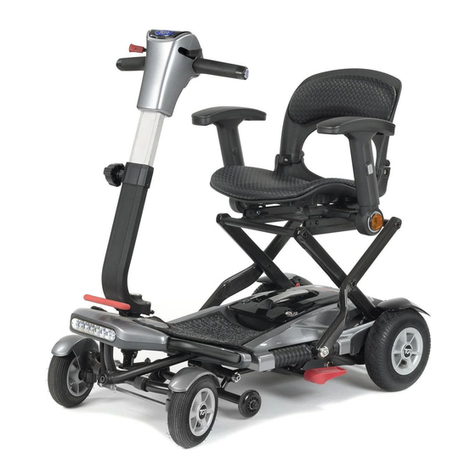
TGA
TGA Minimo Autofold Quick start guide
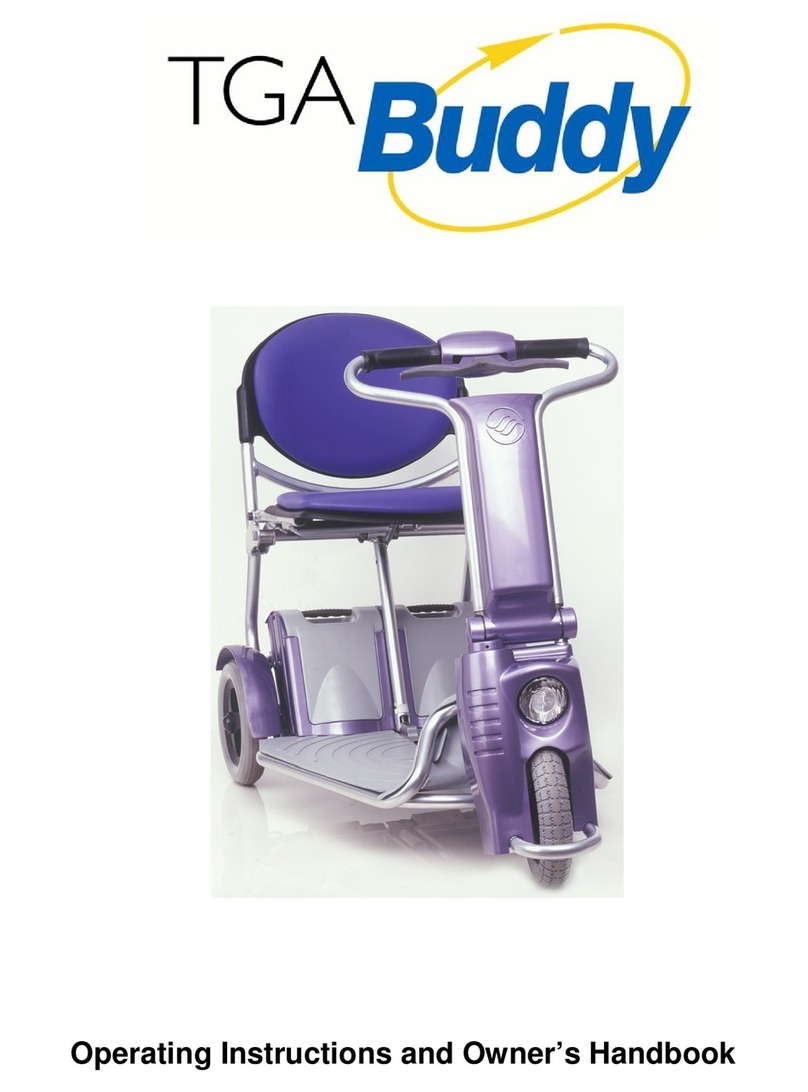
TGA
TGA Buddy Quick start guide
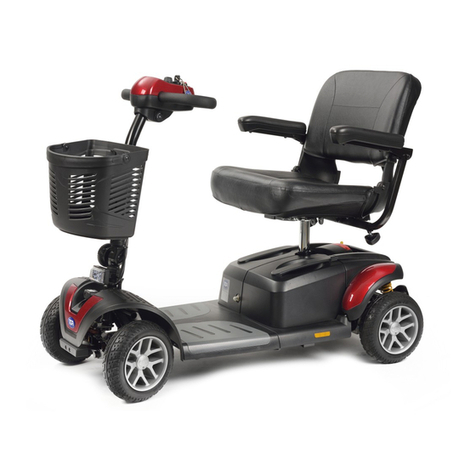
TGA
TGA Zest Quick start guide
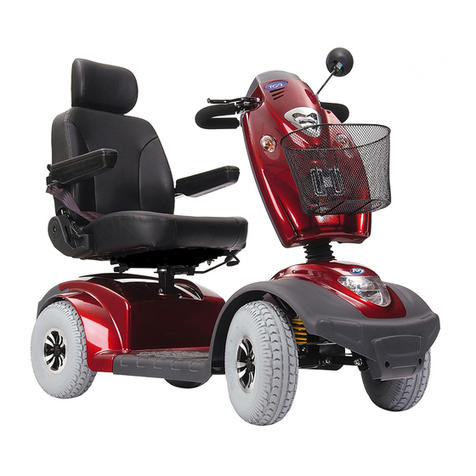
TGA
TGA Mystere Quick start guide

TGA
TGA Eclipse Quick start guide
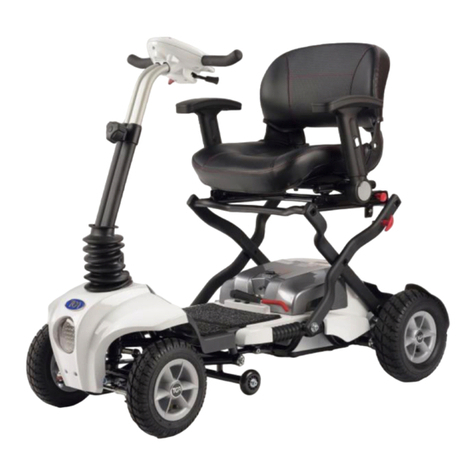
TGA
TGA MAXIMO Quick start guide

TGA
TGA Breeze Midi 3 Quick start guide
